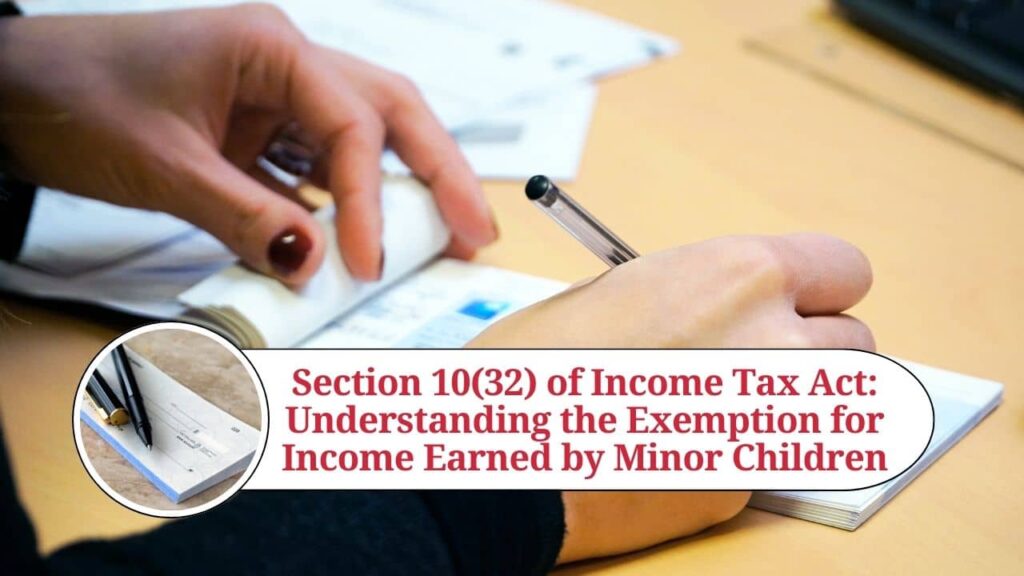Understanding Section 10(32) of the Income Tax Act: Income Exemption for Minor Children
When it comes to tax planning and managing tax liabilities, parents often overlook the potential tax benefits associated with their minor children’s income. Section 10(32) of the Income Tax Act provides a specific exemption for such cases, offering relief to parents whose minor children’s income is includible in their total income under Section 64(1A). This blog will delve into the nuances of Section 10(32), helping you understand how you can optimize your tax benefits.
What is Section 10(32)?
Section 10(32) of the Income Tax Act allows parents to claim an exemption on the income earned by their minor children. According to this provision, any income that is to be included in the total income of a parent under Section 64(1A) is eligible for an exemption of up to ₹1,500 per minor child. This means that if a minor child earns any income, and this income is required to be clubbed with the parent’s total income, the parent can claim an exemption of ₹1,500 per child, thereby reducing their taxable income.
Key Points of Section 10(32)
Applicability:
This exemption applies to the income of minor children that must be included in the parent’s total income under Section 64(1A).
Exemption Limit:
The exemption is capped at ₹1,500 per minor child.
Tax Relief:
The primary benefit of this provision is the reduction of the taxable income of the parent, providing some relief in the overall tax liability.
Practical Example
Consider a scenario where a parent has two minor children. Each child earns ₹2,000 from their investments in a financial year. According to Section 64(1A), the total income of ₹4,000 (₹2,000 per child) is clubbed with the parent’s income. However, under Section 10(32), the parent can claim an exemption of ₹1,500 for each child, reducing the taxable income by ₹3,000. Therefore, only ₹1,000 (₹500 per child) is added to the parent’s total income.
Importance of Keeping Accurate Records
It’s crucial for parents to maintain accurate records of the minor children’s income and investments. Proper documentation helps in claiming the exemption under Section 10(32) and ensures compliance with tax laws. This includes maintaining bank statements, investment receipts, and any other relevant financial documents.
Tax Planning Strategies
Invest in the Child’s Name:
Parents can strategically invest in the name of their minor children to utilize the ₹1,500 exemption effectively.
Diversify Income Sources:
By diversifying the income sources for the minor child, parents can optimize the exemption benefits.
Consult a Tax Professional:
Consulting a tax professional can provide insights into the best ways to utilize this exemption along with other tax-saving strategies.

FAQs
1. What is Section 10(32) of the Income Tax Act?
Section 10(32) provides an exemption for the income of minor children that is includible in the total income of a parent under Section 64(1A). Parents can claim an exemption of up to ₹1,500 per minor child.
2. Who can claim the exemption under Section 10(32)?
Parents whose minor children’s income is included in their total income under Section 64(1A) can claim this exemption.
3. What is the maximum exemption limit under Section 10(32)?
The maximum exemption limit is ₹1,500 per minor child.
4. How is the minor child’s income clubbed with the parent’s income?
As per Section 64(1A), any income earned by a minor child is to be included in the income of the parent with higher income, unless the income is earned by the child due to their own skill, talent, or manual work.
5. Can both parents claim the exemption of ₹1,500 each?
No, the exemption can be claimed only by the parent whose income includes the minor child’s income as per Section 64(1A).
6. What types of income are included under Section 64(1A)?
Typically, income from investments such as interest from bank accounts, fixed deposits, and other similar sources in the name of the minor child is included.
7. Are there any other exemptions or deductions available for minor children’s income?
Besides the ₹1,500 exemption under Section 10(32), there are no additional specific exemptions for minor children’s income. However, any income earned by the minor child due to their own skill, talent, or manual work is not clubbed with the parent’s income.
8. How does this exemption impact the overall tax liability of parents?
By claiming the exemption under Section 10(32), parents can reduce their taxable income, thereby potentially lowering their overall tax liability.
9. What are the documentation requirements to claim this exemption?
Parents need to maintain accurate records of their minor children’s income, including bank statements, investment receipts, and other relevant financial documents to support the claim for this exemption.
10. How can parents maximize their tax savings using Section 10(32)?
Parents can maximize their tax savings by strategically investing in their minor children’s names, diversifying income sources, and consulting with a tax professional to ensure they are utilizing all available tax benefits.
Conclusion
Section 10(32) of the Income Tax Act provides a valuable exemption for parents, helping to reduce their taxable income when minor children’s income is included in their total income under Section 64(1A). By understanding and utilizing this provision, parents can ensure they are not overpaying taxes and can effectively manage their tax liabilities. Make sure to consult with a tax professional to maximize your benefits under this section.
For more detailed insights and expert advice on tax planning, visit SmartTaxSaver.


Leave a Reply